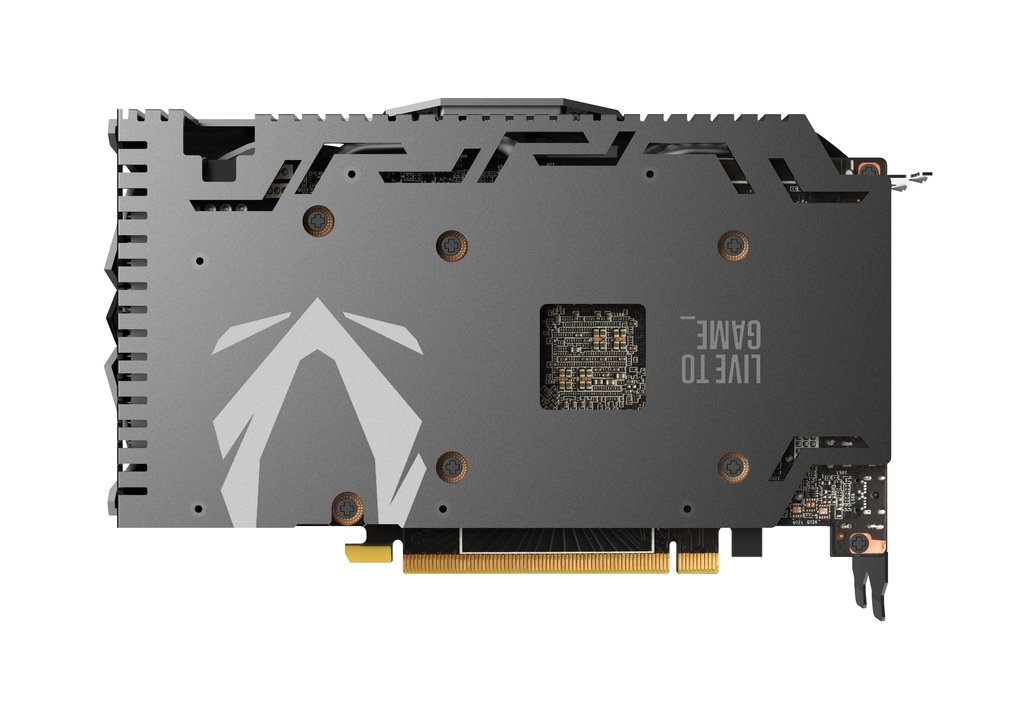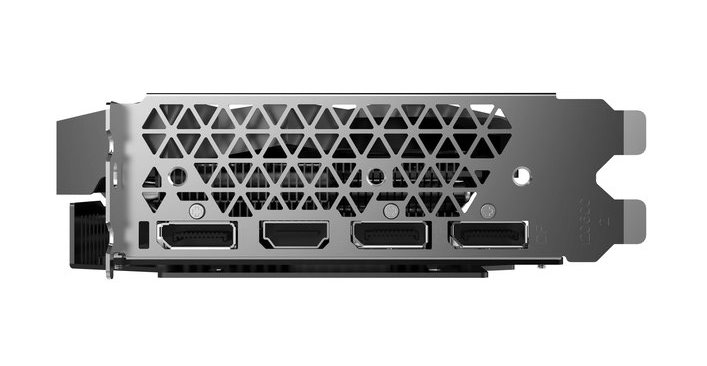Tom's Hardware Verdict
The Zotac GTX 1660 is a 1080p-capable card able to average 60 fps or more across most titles tested. The card is SFF-friendly and quiet under load but, the price is a bit high.
Pros
- +
Small size
- +
good 60fps 1080p ultra performance
- +
Quiet cooling
Cons
- -
No idle ‘fan off’ capability at idle
- -
Price isn't great compared to the GTX 1650 Super
Why you can trust Tom's Hardware
We’ve taken a look at a few of Nvidia’s Super cards recently, in particular, the GeForce GTX 1650 Super and GTX 1660 Super. With both of these cards, we were left with an overall positive impression about the GPUs' performance and value. Sitting between these cards is the GTX 1660 -- a video card that is marketed for 1080p gaming, but with budget considerations in mind.
Now up for review: the Zotac GTX 1660 Amp. Zotac takes the reference values of the GTX 1660 and puts its own twist on things including a factory overclock, improved power delivery and the IceStorm 2.0 cooling solution, all of which improve upon the base specifications.
The GTX 1660 occupies one of the budget spaces in the Turing lineup, alongside the GTX 1650 -- and now, of course, their Super versions. Pricing for the GTX 1660 starts at $219, but will vary by board partner depending on the changes to the card. The Zotac Amp version currently sells for $239.99 on Newegg, and other AIB cards are also floating around that price point.
Like many of these budget cards, Nvidia doesn’t have a reference SKU; there are only reference specifications. The Zotac version we have uses a dual-fan cooler, a single 8-pin PCIe power connector, and is compact -- good to use for small form factor builds.

Features
The GTX 1660 is based on the Turing architecture and uses a variant of the TU116 silicon found in the GTX 1660 and 1660 Ti, just like the 1660 Super. As with other GTX-branded cards, there’s no RTX support here for ray tracing. The TU116 die is manufactured on the 12nm FFN (FinFET Nvidia) process by TSMC, consists of 6.6 billion transistors and measures in at 284 mm². The GTX 1660 brings 1,408 cores, 88 TMUs and 40 ROPS which is cut down from the full TU116 variant found in the GTX 1660 Ti. The Ti version is 1,536 cores, 96 TMUs, and 48 ROPs.

The GTX 1660 uses GDDR6 video memory, just as the Super cards do above and below it. The memory sits on a 192-bit bus, with six 32-bit memory controllers and a 6GB capacity -- a sweet spot for 1080p gaming. Where some 4GB cards will choke when running out memory, 6GB cards have 50% more VRAM to store textures and other bits without swapping out to slower storage off the card.
The Zotac GTX 1660 comes with a 1,530 MHz base clock and 2,001 MHz (8,004 MHZ effective) memory clock. The core boost clock is listed as 1,845 MHz, which is the same as the reference clock. TDP is listed at 130W, 10W over the reference value. Most card partners recommend the GTX 1660 paired with a 350W or greater power supply.
Get Tom's Hardware's best news and in-depth reviews, straight to your inbox.
Like the GTX 1650 Super we’ve reviewed, the GTX 1660 and the TU116 GPU core includes the Turing NVENC encoder, rather than the Volta encoder included in the original GTX 1650 and the TU117 chip. NVENC encoding on the Turing-based cards decreases CPU utilization and improves performance, especially with higher-resolution encoding and decoding.
Below is a complete list of specifications for the lower-end range of Nvidia's current GPUs.
| Header Cell - Column 0 | Geforce GTX 1650 | Geforce GTX 1650 Super | GeForce GTX 1660 | Zotac GTX 1660 AMP |
|---|---|---|---|---|
| Architecture (GPU) | Turing (TU117) | Turing (TU116) | Turing (TU116) | Turing (TU116) |
| ALUs / Stream Processors | 896 | 1280 | 1408 | 1408 |
| Peak FP32 Compute (Based on Typical Boost) | 2.9 TFLOPS | 4.4 TFLOPS | 5 TFLOPS | 5 TFLOPS |
| Tensor Cores | N/A | N/A | N/A | N/A |
| RT Cores | N/A | N/A | N/A | N/A |
| Texture Units | 56 | 80 | 88 | 88 |
| ROPs | 32 | 32 | 48 | 48 |
| Base Clock Rate | 1485 MHz | 1530 MHz | 1530 MHz | 1530 MHz |
| Nvidia Boost/AMD Game Rate | 1665 MHz | 1725 MHz | 1785 MHz | 1845 MHz |
| AMD Boost Rate | N/A | N/A | N/A | N/A |
| Memory Capacity | 4GB GDDR5 | 4GB GDDR6 | 4GB GDDR5 | 4GB GDDR5 |
| Memory Bus | 128-bit | 128-bit | 192-bit | 192-bit |
| Memory Bandwidth | 128 GB/s | 192 GB/s | 192.1 GB/s | 192.1 GB/s |
| L2 Cache | 1MB | 1.5MB | 1.5MB | 1.5MB |
| TDP | 75W | 100W | 120W | 130W |
| Transistor Count | 4.7 billion | 6.6 billion | 6.6 billion | 6.6 billion |
| Die Size | 200 mm² | 284 mm² | 284 mm² | 284 mm² |

Design
Zotac’s GTX 1660 Amp Measures 8.3 x 4.7 x 1.61-inches (209.6 x 119.3 x 41mm) and is a true dual-slot card, allowing users to use the slot below (albeit without much room between it and the intake for the card). The card’s relatively small size will allow it to fit in more builds than full-sized GPUs. Like the previous Zotac GTX 1650 Super we looked at, Zotac says this card should also fit in "99%" of systems. As always, double-check your chassis specifications to make sure it will fit.




The design of the card is subtle and standard fare, with a grey shroud surrounding two 90mm fans. The shroud uses sharp angles throughout, almost giving it a stealth-like appearance, like it was trying to avoid radar. On top is the Zotac Gaming branding in black, along with the GeForce GTX branding, while the back of the card sports a wraparound backplate. This is for rigidity and protection, as it does not use thermal pads to efficiently remove heat from the PCB. If you want RGB lighting in your system, you won't find any from this card.

The Zotac GTX 1660 Amp uses dual 90mm fans to move air into the full-size heatsink. The blades have small stripes/channels on them which the company says breaks the flow of air into smaller channels, enabling more optimized airflow and quieter rotation.
The heatsink below is made of aluminum and uses a wide array/full body for increased heat dissipation. Three 6mm heat pipes meander their way through the fin stack, starting directly above the GPU. Making direct contact with the video card die is a copper plate which is in direct contact with the heat pipes. There is a metal plate surrounding the copper, which is designed to cool the Samsung memory. The VRMs are also cooled by the heatsink using a thick thermal pad between it and the contact point on the fin array.
The cooling solution proved relatively quiet throughout testing and kept the card running cool. I just wish the fans stopped on idle or low loads for true silent operation.

Looking at the PCB and power delivery, we are able to see a total of eight phases, which are separated into a 6+2 configuration. Power is managed on the board by a uPI 9512 voltage regulator that's able to run up to 8 channels. A single 8-pin PCIe connector sends power to the VRMs, which are plenty capable of delivering the necessary power for stock and overclocked operations.

There are four ports on this card: three DisplayPorts (v1.4) and a single HDMI (2.0b). This is typical of this class of card, though it does vary by vendor. Gone are the legacy ports we've seen in past generations of cards -- sorry DVI!
How We Tested Zotac’s GTX 1660 Amp
We’ve updated our GPU test system to a new platform and swapped from a six-core i7-8086K to an eight-core Core i9-9900K. The CPU sits in an MSI Z390 MEG Ace motherboard, along with 2x16GB Corsair DDR4 3200 MHz CL16 RAM (CMK32GX4M2B3200C16). A Corsair H150i Pro RGB AIO keeps the CPU cool along with a 120mm Sharkoon fan for airflow across the test system. A single 2TB Kingston KC2000 NVMe PCIe 3.0 x4 drive stores our OS and gaming suite.
The motherboard was updated to the latest (at the time of testing) BIOS (version 7B12v16), from August 2019. Optimized defaults were used to set up the system. We then enabled the memory’s XMP profile to get the memory running at the rated 3200 MHz CL16 specification. No other changes or performance enhancements were enabled. Windows 10 (1903) was used.
As time goes on we will build our database of results back up based on this test system. For now we are including GPUs that are close in performance to this GPU. We have a Gigabyte GTX 1650 Gaming OC, EVGA GTX 1660 Super SC Ultra, Zotac GTX 1650 Super, Representing AMD is an XFX RX 590 Fat Boy, Sapphire RX 5500 XT Pulse and Gigabyte RX 5500 XT Gaming OC 8G.
Our list of games test games is currently Tom Clancy’s The Division 2, Ghost Recon: Breakpoint, Borderlands 3, Gears of War 5, Strange Brigade, Shadow of The Tomb Raider, Far Cry 5, Metro: Exodus, Final Fantasy XIV: Shadowbringers, Forza Horizon 4 and Battlefield V. These titles represent a broad spectrum of genres and APIs, which gives us a good idea of the relative performance difference between the cards. We’re using driver build 441.20 for the Nvidia cards and Adrenalin 2019 Edition 19.11.3 for AMD.
We capture our frames per second (fps) and frame time information by running OCAT during our benchmarks. In order to capture clock and fan speed, temperature and power, we u se GPU-Z's logging capabilities. Soon we’ll resume using the Powenetics based system found in previous reviews, as soon as the equipment is ready.
MORE: Best Graphics Cards
MORE: Desktop GPU Performance Hierarchy Table
MORE: All Graphics Content
Current page: Features and Specifications
Next Page Performance Results: 1920 x 1080 (Ultra)
Joe Shields is a staff writer at Tom’s Hardware. He reviews motherboards and PC components.